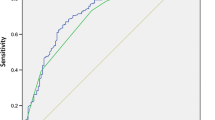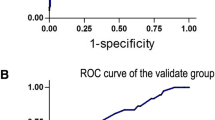Abstract
Background
Soft pancreatic texture is a commonly accepted risk factor associated with pancreatic fistula (PF) after pancreaticoduodenectomy (PD). However, its evaluation is subjective and its predictive value is limited. The present study was performed to establish intraoperative PF prediction parameter: the pathological assessment of pancreatic fibrosis, which was an objective evaluation that was strongly related to pancreatic consistency.
Methods
Based on the results of a retrospective investigation on grades of pancreatic fibrosis and PF occurrence in 51 consecutive patients, an algorithm for intraoperative selection of early prophylactic drain removal was established. Prophylactic drains of patients with pancreatic fibrosis ≥30 % in the frozen section of pancreatic stump were removed on postoperative day (POD) 4. As CRP ≥10 mg/dL on POD 4 was a strong risk factor for PF in patients with fibrosis <30 %, the drains of these patients were maintained.
Results
The algorithm was applied to 26 consecutive patients. Prophylactic drains were removed in 14 patients and retained in 12 patients on POD 4. No PF was observed in patients with pancreatic fibrosis ≥30 % (n = 8). Among six patients with fibrosis <30 %, CRP <10 mg/dL, and without infection in the drain fluid, only two developed grade A PF. All nine patients with pancreatic fibrosis <30 % and CRP ≥10 mg/dL developed grade B PF. No grade C PF was observed in any group.
Conclusions
The pathological evaluation of pancreatic fibrosis could objectively predict PF occurrence. Intraoperative assessment of pancreatic fibrosis could be applied to tailor postoperative drain management after PD.



Similar content being viewed by others
Abbreviations
- BMI:
-
Body mass index
- CRP:
-
C-reactive protein
- H&E:
-
Hematoxylin and eosin
- IPMN:
-
Intraductal papillary mucinous neoplasm
- PD:
-
Pancreaticoduodenectomy
- PF:
-
Pancreatic fistula
- SSPPD:
-
Subtotal stomach preserving pancreaticoduodenectomy
- POD:
-
Postoperative day
- WBC:
-
White blood cell
References
Nagakawa Y, Matsudo T, Hijikata Y et al (2013) Bacterial contamination in ascitic fluid is associated with the development of clinically relevant pancreatic fistula after pancreatoduodenectomy. Pancreas 42:701–706
Kobayashi S, Gotohda N, Kato Y et al (2013) Infection control for prevention of pancreatic fistula after pancreaticoduodenectomy. Hepatogastroenterology 60:876–882
Fuks D, Piessen G, Huet E et al (2009) Life-threatening postoperative pancreatic fistula (grade C) after pancreaticoduodenectomy: incidence, prognosis, and risk factors. Am J Surg 197:702–709
Tani M, Kawai M, Yamaue H (2008) Intraabdominal hemorrhage after a pancreatectomy. J Hepatobiliary Pancreat Surg 15:257–261
Kawai M, Tani M, Terasawa H et al (2006) Early removal of prophylactic drains reduces the risk of intra-abdominal infections in patients with pancreatic head resection. Ann Surg 244:1–7
Bassi C, Molinari E, Malleo G et al (2010) Early versus late drain removal after standard pancreatic resections: results of a prospective randomized trial. Ann Surg 252:207–214
Pratt WB, Callery MP, Vollmer CM Jr (2009) The latent presentation of pancreatic fistulas. Br J Surg 96:641–649
Hashimoto Y, Traverso LW (2010) Incidence of pancreatic anastomotic failure and delayed gastric emptying after pancreatoduodenectomy in 507 consecutive patients: use of a web-based calculator to improve homogeneity of definition. Surgery 147:503–515
Gaujoux S, Cortes A, Couvelard A et al (2010) Fatty pancreas and increased body mass index are risk factors of pancreatic fistula after pancreaticoduodenectomy. Surgery 148:15–23
Kajiwara T, Sakamoto Y, Morofuji N et al (2010) An analysis of risk factors for pancreatic fistula after pancreaticoduodenectomy: clinical impact of bile juice infection on day 1. Langenbecks Arch Surg 395:707–712
Lin JW, Cameron JL, Yeo CJ et al (2004) Risk factors and outcomes in postpancreaticoduodenectomy pancreaticocutaneous fistula. J Gastrointest Surg 8:951–959
Pratt WB, Callery MP, Vollmer CM Jr et al (2008) Risk prediction for development of pancreatic fistula using the ISGFF classification scheme. World J Surg 32:419–428. doi:10.1007/s00268-007-9388-5
Belyaev O, Munding J, Herzog T et al (2011) Histomorphological features of the pancreatic remnant as independent risk factors for postoperative pancreatic fistula: a matched-pairs analysis. Pancreatology 11:516–524
Mathur A, Pitt HA, Marine M (2007) Fatty pancreas: a factor in postoperative pancreatic fistula. Ann Surg 246:1058–1064
Wellner UF, Kayser G, Lapshyn H (2010) A simple scoring system based on clinical factors related to pancreatic texture predicts postoperative pancreatic fistula preoperatively. HPB (Oxf) 12:696–702
Kakita A, Yoshida M, Takahashi T (2001) History of pancreaticojejunostomy in pancreaticoduodenectomy: development of a more reliable anastomosis technique. J Hepatobiliary Pancreat Surg 8:230–237
Bassi C, Dervenis C, Butturini G et al (2005) Postoperative pancreatic fistula: an international study group (ISGPF) definition. Surgery 138:8–13
Tajima Y, Matsuzaki S, Furui J et al (2004) Dynamic magnetic resonance imaging to evaluate remnant pancreatic fibrosis. Br J Surg 91:595–600
Belyaev O, Herden H, Meier JJ et al (2010) Assessment of pancreatic hardness-surgeon versus durometer. J Surg Res 158:53–60
Lee TK, Kang CM, Park MS et al (2014) Prediction of postoperative pancreatic fistulas after pancreatectomy: assessment with acoustic radiation force impulse elastography. J Ultrasound Med 33:781–786
Ridolfi C, Angiolini MR, Gavazzi F (2014) Morphohistological features of pancreatic stump are the main determinant of pancreatic fistula after pancreatoduodenectomy. Biomed Res Int 2014:641239
Klöpper G, Maillet B (1991) Pseudocysts in chronic pancreatitis: a morphological analysis of 57 resection specimens and 9 autopsy pancreata. Pancreas 6:266–274
Adachi E, Harimoto N, Yamashita Y et al (2013) Pancreatic leakage test in pancreaticoduodenectomy: relation to degree of pancreatic fibrosis, pancreatic amylase level and pancreatic fistula. Fzakuoka Igaku Zasshi 104:490–498
Uchida E, Tajiri T, Nakamura Y et al (2002) Relationship between grade of fibrosis in pancreatic stump and postoperative pancreatic exocrine activity after pancreaticoduodenectomy: with special reference to insufficiency of pancreaticointestinal anastomosis. J Nippon Med Sch 69:549–556
Welsch T, Frommhold K, Hinz U et al (2008) Persisting elevation of C-reactive protein after pancreatic resections can indicate developing inflammatory complications. Surgery 143:20–28
Uemura K, Murakami Y, Sudo T et al (2014) Indicators for proper management of surgical drains following pancreaticoduodenectomy. J Surg Oncol 109:702–707
Kosaka H, Kuroda N, Suzumura K et al (2014) Multivariate logistic regression analysis for prediction of clinically relevant pancreatic fistula in the early phase after pancreaticoduodenectomy. J Hepatobiliary Pancreat Sci 21:128–133
Acknowledgments
The authors would like to thank Enago for the English language review.
Author information
Authors and Affiliations
Corresponding author
Ethics declarations
Conflict of interest
The authors declare no conflict of interest.
Rights and permissions
About this article
Cite this article
Kiyochi, H., Matsukage, S., Nakamura, T. et al. Pathologic Assessment of Pancreatic Fibrosis for Objective Prediction of Pancreatic Fistula and Management of Prophylactic Drain Removal After Pancreaticoduodenectomy. World J Surg 39, 2967–2974 (2015). https://doi.org/10.1007/s00268-015-3211-5
Published:
Issue Date:
DOI: https://doi.org/10.1007/s00268-015-3211-5




